The Los Angeles County Arboretum is a 127-acre botanical garden and historical site with plants from around the world. Founded in 1948 by the County and the California Arboretum Foundation, its mission is to foster understanding, awareness
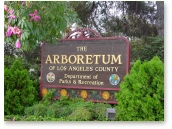 and appreciation of the role of plants in nature and how they relate to human affairs. Each plant in this extensive collection is labeled and partitioned by the continent of its origin. The Arboretum offers many horticultural/botanical classes, programs, shows, and workshops throughout the year for people of all ages, and also hosts arts and craft expositions, summer camps, educational fairs, field walks, and outdoor concerts. Additionally, because the Arboretum was established on land with a long history of settlement, it includes many historical buildings and preserved artifacts. Located just south of Interstate 210, Foothill Freeway, at 301 North Baldwin Avenue in Arcadia, the Arboretum is across from the Santa Anita Race Track and approximately 15 miles from Los Angeles.
and appreciation of the role of plants in nature and how they relate to human affairs. Each plant in this extensive collection is labeled and partitioned by the continent of its origin. The Arboretum offers many horticultural/botanical classes, programs, shows, and workshops throughout the year for people of all ages, and also hosts arts and craft expositions, summer camps, educational fairs, field walks, and outdoor concerts. Additionally, because the Arboretum was established on land with a long history of settlement, it includes many historical buildings and preserved artifacts. Located just south of Interstate 210, Foothill Freeway, at 301 North Baldwin Avenue in Arcadia, the Arboretum is across from the Santa Anita Race Track and approximately 15 miles from Los Angeles.
Baldwin Lake is a four-acre body of water located within the heart of the Arboretum's Historical Section and surrounded by the Tropical Forest on the north side. Native American
occupation of this area dates back three thousand years
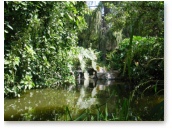 to when villages were established alongside lakes and rivers because food was readily available. Village names often reflected their native settings. For example, Hukngna (El Monte) meant “in the weeping willow trees”; Kuruvungna (Santa Monica) was “a place we are in the sun”; and Topanga was “a place where mountains run into the sea.” Likewise, the early inhabitants of today’s Arboretum called their home site Aleupkigna, “the place of many waters.” These “many waters” were due to the geology of the San Gabriel Valley, one of Southern California’s primary valleys and an integral part of the Greater Los Angeles metropolitan area. The San Gabriel Valley is bisected by the Raymond Hill Fault, the flexure of which serves as a subterranean dam. A multitude of fault-related features such as steep scarps, fault ridges, depressions and springs characterized much of the west Valley, creating an abundance of surface and artesian water. The Arboretum's Tallac Knoll is a hill created by the upward pressure along the faults that surround it. The adjacent Baldwin Lake, another fault-related feature, is technically called a sag pond or fault depression, the opposite of Tallac Knoll on its west.
to when villages were established alongside lakes and rivers because food was readily available. Village names often reflected their native settings. For example, Hukngna (El Monte) meant “in the weeping willow trees”; Kuruvungna (Santa Monica) was “a place we are in the sun”; and Topanga was “a place where mountains run into the sea.” Likewise, the early inhabitants of today’s Arboretum called their home site Aleupkigna, “the place of many waters.” These “many waters” were due to the geology of the San Gabriel Valley, one of Southern California’s primary valleys and an integral part of the Greater Los Angeles metropolitan area. The San Gabriel Valley is bisected by the Raymond Hill Fault, the flexure of which serves as a subterranean dam. A multitude of fault-related features such as steep scarps, fault ridges, depressions and springs characterized much of the west Valley, creating an abundance of surface and artesian water. The Arboretum's Tallac Knoll is a hill created by the upward pressure along the faults that surround it. The adjacent Baldwin Lake, another fault-related feature, is technically called a sag pond or fault depression, the opposite of Tallac Knoll on its west.
When the Spanish arrived in California in the early 1700s, the area which comprises the Arboretum and its surroundings, Aleupkigna, was inhabited by the Gabrielino Indians.
Named after the San Gabriel Mission where they were converted to Christianity,
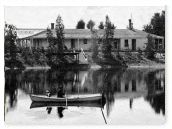 the Gabrielino were actually descendants of the Shoshoneans who arrived in California around 1000 to 500 B.C. The land on which they lived became known as Rancho Santa Anita, an agricultural outpost of Mission San Gabriel. In 1839, Hugo Reid, a Scotsman with both Mexican citizenship and a Gabrelino wife, applied for title to 13,319 acres of land and became the first private owner of Rancho Santa Anita. In 1840, Reid constructed his adobe house next to what is now called Baldwin Lake. Reid's hand-drawn map of his rancho indicated a cienega (a spring or swamp) at the lake site. Over the next several decades, the property passed through several owners including Henry Dalton, Joseph A. Rowe, Albert Dibblee, William Corbitt, William Wolfskill, Leonard Rose, Louis Wolfskill, Alfred Chapman and Harris Newmark. In 1875, Elias Jackson "Lucky" Baldwin purchased for $200,000 the 8,500 acres of the Rancho Santa Anita that still remained intact. The acquisition included the natural lakes and cienegas on the property, as well as water rights in both Big and Little Santa Anita Canyons just north of his home site.
the Gabrielino were actually descendants of the Shoshoneans who arrived in California around 1000 to 500 B.C. The land on which they lived became known as Rancho Santa Anita, an agricultural outpost of Mission San Gabriel. In 1839, Hugo Reid, a Scotsman with both Mexican citizenship and a Gabrelino wife, applied for title to 13,319 acres of land and became the first private owner of Rancho Santa Anita. In 1840, Reid constructed his adobe house next to what is now called Baldwin Lake. Reid's hand-drawn map of his rancho indicated a cienega (a spring or swamp) at the lake site. Over the next several decades, the property passed through several owners including Henry Dalton, Joseph A. Rowe, Albert Dibblee, William Corbitt, William Wolfskill, Leonard Rose, Louis Wolfskill, Alfred Chapman and Harris Newmark. In 1875, Elias Jackson "Lucky" Baldwin purchased for $200,000 the 8,500 acres of the Rancho Santa Anita that still remained intact. The acquisition included the natural lakes and cienegas on the property, as well as water rights in both Big and Little Santa Anita Canyons just north of his home site.
The Baldwin Ranch was situated on a 2,000-acre artesian belt, a benefit of its location atop the Raymond Hill Fault. Sixty percent of the ranch’s irrigation water came from artesian
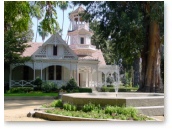 sources, while canyon waters provided the remaining forty percent. The springs that feed Lake Baldwin are located in both the north and south inlets, and the lake served as a holding reservoir for ranch irrigation projects. In the late 1880s, Lucky Baldwin dredged and deepened the lake approximately 15 feet, and constructed a retaining wall capped by granite boulders.
sources, while canyon waters provided the remaining forty percent. The springs that feed Lake Baldwin are located in both the north and south inlets, and the lake served as a holding reservoir for ranch irrigation projects. In the late 1880s, Lucky Baldwin dredged and deepened the lake approximately 15 feet, and constructed a retaining wall capped by granite boulders.
In 1885, Lucky built “Baldwin's Belvedere”, a charming little house situated on a peninsula jutting out into the horseshoe-shaped lake. Known today as the Queen Anne Cottage, it was probably constructed as a honeymoon gift for Baldwin's fourth wife, sixteen year-old Lillie Bennett. Designed by Lillie's father, Albert A. Bennett, the cottage featured marble fireplace mantels, black walnut doors, and stained glass windows. The original artesian well still stands in front of the house. Unfortunately, the newlyweds never got to enjoy the elegant house, for they separated shortly after it was completed. Baldwin soon converted the one-time gift for his fourth wife into a memorial to his third wife, Jennie Dexter, who had died in 1881. A stained glass portrait of Jennie stood at the front door and an almost life-size oil painting of her was hung in the parlor. Both pieces remain there today.
By the time of Baldwin's death in 1909, the size of the property had decreased to 3,500 acres. Two of his children, Clara and Anita Baldwin, inherited the property, with Anita taking an active interest in the business of running the Rancho. Anita, born in 1876 to Jennie Dexter, closed the Cottage and disposed of all furnishings. Fortunately, Anita removed and stored detachable components such as the doors, stained glass windows, mantels, hearth tiles, and tile mosaic floors in the Coach Barn. Eventually, all of these items, plus the original bathroom fixtures and the exterior marble walkway, were returned to the Cottage during the restoration of 1951-53. Today, the Queen Anne Cottage is listed on the National Register of Historic Places.
From 1909 until 1936, the acreage of the Rancho continued to decrease as parcels were sold off. When only 1,300 acres remained, the property was sold to a real estate syndicate, Rancho Santa Anita, Inc., which was headed by Harry
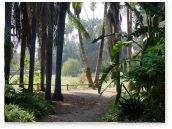 Chandler of the Los Angeles Times. Finally, in 1947 the State of California and County of Los Angeles jointly purchased 111 acres from Rancho Santa Anita for $320,000 to create an arboretum around the Baldwin home site. The California Arboretum Foundation was incorporated the following year as a non-profit organization to sublease and administer the Los Angeles State and County Arboretum.
Chandler of the Los Angeles Times. Finally, in 1947 the State of California and County of Los Angeles jointly purchased 111 acres from Rancho Santa Anita for $320,000 to create an arboretum around the Baldwin home site. The California Arboretum Foundation was incorporated the following year as a non-profit organization to sublease and administer the Los Angeles State and County Arboretum.
By 1948, filmmaking in the area was well established; moviemakers had utilized Baldwin Lake as a stand-in for swamps, lakes, rivers, and even South Pacific lagoons since 1936. As a way to reference it as a film location in the early Arboretum days, Baldwin Lake was designated as LASCA (Los Angeles State and County Arboretum) Lagoon. Johnny Weissmuller swam in LASCA Lagoon for three decades, first as Tarzan and later as Jungle Jim. In fact, the first film to be shot at Baldwin Lake most likely was Metro-Goldwyn-Mayer's Tarzan Escapes! (1936), starring Johnny Weissmuller and Maureen O'Sullivan. During filming, the working title for this movie was The Capture of Tarzan, but was later changed to depict a more optimistic and action-packed plot. Besides Tarzan, other jungle adventures that have been filmed at the Arboretum include Paramount's jungle expedition Safari (1940), starring Douglas Fairbanks, Jr. and Madeleine Carroll. In this movie, a paddlewheel boat is sunk in Baldwin Lake. That same year, Paramount’s first of seven Road entries, Road to Singapore (1940), saw Bing Crosby, Dorothy Lamour, and Bob Hope take up a month-long watery residence at Baldwin Lake. Coincidently, three years prior Bing Crosby appeared in Waikiki Wedding (1937), which also used Baldwin Lake and its surroundings as an island backdrop. In addition to teaming up with Bing Crosby for the popular Road pictures, Dorothy Lamour also paired with Robert Preston in other island adventure romances including Moon Over Burma (1940) and Typhoon (1940), both from Paramount. This tropical setting can also be seen in 20th Century Fox's Manila Calling (1942) starring Lloyd Nolan and Cornel Wilde, Universal's Cobra Woman (1944) starring Maria Montez and Jon Hall, and Warner Brothers' Passage to Marseille (1944) starring Humphrey Bogart and Claude Rains. In fact, even though every major studio of the time – the “Big Five” (20th Century Fox, Metro-Goldwyn-Mayer, Paramount, RKO and Warner Brothers) and the “Little Three” (Columbia, United Artists and Universal) – supported jungles on their backlots, all of them would eventually come to use Baldwin Lake and its environs for filming.
Metro-Goldwyn-Mayer’s loss of interest in the Tarzan series was evident in the later offerings, which were characterized by increasingly contrived plots and the often-excessive comedy relief of Cheetah the Chimp. When family interest in the films was sparked by the arrival of Johnny Sheffield as Boy, MGM sold the rights to producer, Sol Lesser,
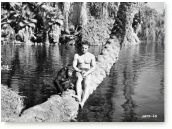 following the completion of their 6th installment, Tarzan's New York Adventure (1942). Needing to find a location to film his new acquisition, Sol Lesser decided on RKO Studios which had sound stages in Hollywood and Culver City, as well as a movie ranch in Encino and a backlot at the Culver City facility nicknamed “Forty Acres.” It was here that Lesser built the Tarzan tree house in a jungle area separated from the main backlot by Ballona Creek. While many Tarzan jungle scenes were filmed at the backlot, Lesser also used the Baldwin Lake area for jungle and river scenes in several films including Tarzan and the Amazons (1945), Tarzan and the Leopard Woman (1946), and Tarzan and the Huntress (1947), all starring Johnny Weissmuller, Brenda Joyce and Johnny Sheffield.
following the completion of their 6th installment, Tarzan's New York Adventure (1942). Needing to find a location to film his new acquisition, Sol Lesser decided on RKO Studios which had sound stages in Hollywood and Culver City, as well as a movie ranch in Encino and a backlot at the Culver City facility nicknamed “Forty Acres.” It was here that Lesser built the Tarzan tree house in a jungle area separated from the main backlot by Ballona Creek. While many Tarzan jungle scenes were filmed at the backlot, Lesser also used the Baldwin Lake area for jungle and river scenes in several films including Tarzan and the Amazons (1945), Tarzan and the Leopard Woman (1946), and Tarzan and the Huntress (1947), all starring Johnny Weissmuller, Brenda Joyce and Johnny Sheffield.
Because he had outgrown the part, Johnny Sheffield’s last appearance as Boy was in Tarzan and the Huntress (1947). His jungle roles were not over, however. Walter Mirish, a producer at Monogram Studios, decided to make a series of low-budget adventure films based on Roy Rockwood's popular juvenile books from the 1920s about Bomba, a boy who grew up in the jungle.
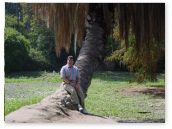 Sheffield was chosen for the lead role as Bomba, and with veteran serial and B-picture director Ford Beebe at the helm, the series became extremely popular with younger audiences. From the first entry, Bomba on Panther Island (1949), to the last, Lord of the Jungle (1955), all eleven episodes were filmed at Baldwin Lake and its surroundings, which as of 1948 had become part of the Arboretum.
Sheffield was chosen for the lead role as Bomba, and with veteran serial and B-picture director Ford Beebe at the helm, the series became extremely popular with younger audiences. From the first entry, Bomba on Panther Island (1949), to the last, Lord of the Jungle (1955), all eleven episodes were filmed at Baldwin Lake and its surroundings, which as of 1948 had become part of the Arboretum.
Filmed on-location in Mexico, Tarzan and the Mermaids (1948) was Johnny Weismuller’s twelfth and last Tarzan movie. After having played the role for sixteen years, Weissmuller decided to hang up his loincloth. It was not long before Columbia Pictures' producer Sam Katzman proposed a new series that would enable the more mature but still rugged star to cavort in familiar surroundings. The series, Jungle Jim, was presold as a successful comic strip and radio show. Aimed primarily at juvenile audiences, the series performed well at the box office and could be summed up as “Tarzan with clothes on.” A total of sixteen Jungle Jim films were produced, but in the last three films, Cannibal Attack (1954), Devil Goddess (1955), and Jungle Moon Men (1955), the name Jungle Jim was dropped and Weissmuller played himself. The format remained the same, however, with Johnny's ever-faithful chimpanzee friend, Tamba, at his side. As in the case of the Tarzan series, many of the jungle and water scenes were filmed at the Arboretum.
Following the departure of Weissmuller, the legacy of Tarzan continued with Lex Barker in the lead role for the next five entries. Two of these, Tarzan and the Slave Girl (1950) and Tarzan's Peril (1951), were filmed at the Arboretum. Tarzan's Hidden Jungle (1955), starring Gordon Scott, featured the last appearance of the Arboretum in newly filmed material. Stock footage of the Arboretum edited together from three half-hour episodes for a Tarzan television series that never got off the ground was used in Tarzan and the Trappers (1958) starring Gordon Scott and Eve Brent. As a theatrical release, this Tarzan film was considered third-rate; but considering it was intended for the Saturday matinee juvenile audience of the 1950s, Tarzan and the Trappers was probably better than other low-budget movies of the same era.
In addition to playing host to the Tarzan, Jungle Jim and Bomba series of films, the Arboretum has also played a significant role in many other adventure movies, as well as some period films. Examples include The Golden Hawk (1952) starring Rhonda Fleming and Sterling Hayden, the film adaptation of Frank Yerby's novel about 17th century Spanish and French pirates in the Caribbean; Royal African Rifles (1953) starring Louis Hayward and Michael Pate, a film about a British officer who leads a mission in Africa to recover a cache of arms in 1910; Appointment in Honduras (1953) starring Glenn Ford and Ann Sheridan, about an idealistic American who sets out to save a Latin American country; The Gambler From Natchez (1954) starring Dale Robertson and Debra Paget, about a son's vindication of his father's murder by three men; and Beachhead (1954) starring Tony Curtis and Frank Lovejoy, the story of two soldiers stranded on a Japanese-occupied island in WWII.
While it has been an excellent film site for the adventure genre, the Arboretum has also been well-suited for sci-fi and horror flicks. Two such films lensed at this location were The Cyclops (1957) starring James Craig and Gloria Talbot, and the cult favorite Attack of the Giant Leeches (1959) starring Ken Clark and Yvette Vickers. Filmmakers in the 1960s showed little interest in the Arboretum, but in the 1970s it was utilized in Paramount's Marathon Man (1976) starring Dustin Hoffman and Laurence Olivier; Universal's MacArthur (1977) starring Gregory Peck and Ivan Bonar; and a number of made-for-TV mini-series, the most notable being Roots: The Next Generations (1979), a popular saga highlighting Alex Haley's family line.
Since its beginnings in the 1950s, television has recognized the Arboretum as a prime location for a variety of productions. The first television series to use Baldwin Lake and its surroundings was probably Ramar of the Jungle, starring Jon Hall and Ray Montgomery. Directed by Spencer Bennett, the series ran from 1952-54 (52 episodes) and dealt with Dr. Tom Reynolds (Hall), the son of missionaries, whose return to the jungle to treat natives (Ramar means “white medicine man”) with his associate Professor Howard Ogden (Montgomery) invariably involved overcoming bad guys as well. Another jungle outing from the 1950s popular with juvenile audiences was Sheena, Queen of the Jungle. Based on the comic strip character, the series ran for one season (26 episodes) and starred pin-up model Irish McCalla as the jungle queen. The Arboretum can also be seen in an episode of the very popular underwater adventure Sea Hunt, starring Lloyd Bridges as Mike Nelson.
During the 1960s, television shows that had episodic filming at the Arboretum included Lassie, Daniel Boone, Green Hornet and Mission Impossible. In the 1970s, the locale was used more extensively and in a variety of programs: The Immortal, Longstreet, The Six Million Dollar Man,
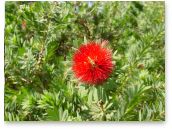 The Bionic Woman, Wonder Woman, Man from Atlantis, Love Boat, Fantasy Island, The Misadventures of Sheriff Lobo, and Buck Rogers in the 25th Century. The most popular of these, Fantasy Island, ran for six seasons (157 episodes) and made the Queen Anne Cottage and its tower world famous. The series’ film editor combined real tropical island film footage (rugged coastline, waterfalls, etc.) with scenes of Baldwin Lake and the Queen Anne Cottage to create the beginning of
The Bionic Woman, Wonder Woman, Man from Atlantis, Love Boat, Fantasy Island, The Misadventures of Sheriff Lobo, and Buck Rogers in the 25th Century. The most popular of these, Fantasy Island, ran for six seasons (157 episodes) and made the Queen Anne Cottage and its tower world famous. The series’ film editor combined real tropical island film footage (rugged coastline, waterfalls, etc.) with scenes of Baldwin Lake and the Queen Anne Cottage to create the beginning of
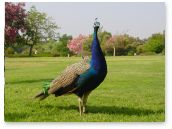 each weekly episode. Starring Ricardo Montalban and Herve Villechaize, the series involved tales of visitors who had paid $50,000 each to live out their fantasies in a unique island setting. Each episode began with Tattoo (Villechaize) climbing up the Queen Anne Cottage tower to ring the bell and proclaim the arrival of guests with shouts of “De plane! De plane!” In the years that followed, the Arboretum was used in several other television dramas such as Dallas, Hart to Hart, Knots Landing, Flamingo Road, The Fall Guy, Dynasty, Falcon Crest, Bring 'Em Back Alive, Matt Houston, Remington Steele, and Scarecrow and Mrs. King, and to this day, both film and television continue to use this magnificent botanical garden as a backdrop for their productions.
each weekly episode. Starring Ricardo Montalban and Herve Villechaize, the series involved tales of visitors who had paid $50,000 each to live out their fantasies in a unique island setting. Each episode began with Tattoo (Villechaize) climbing up the Queen Anne Cottage tower to ring the bell and proclaim the arrival of guests with shouts of “De plane! De plane!” In the years that followed, the Arboretum was used in several other television dramas such as Dallas, Hart to Hart, Knots Landing, Flamingo Road, The Fall Guy, Dynasty, Falcon Crest, Bring 'Em Back Alive, Matt Houston, Remington Steele, and Scarecrow and Mrs. King, and to this day, both film and television continue to use this magnificent botanical garden as a backdrop for their productions.